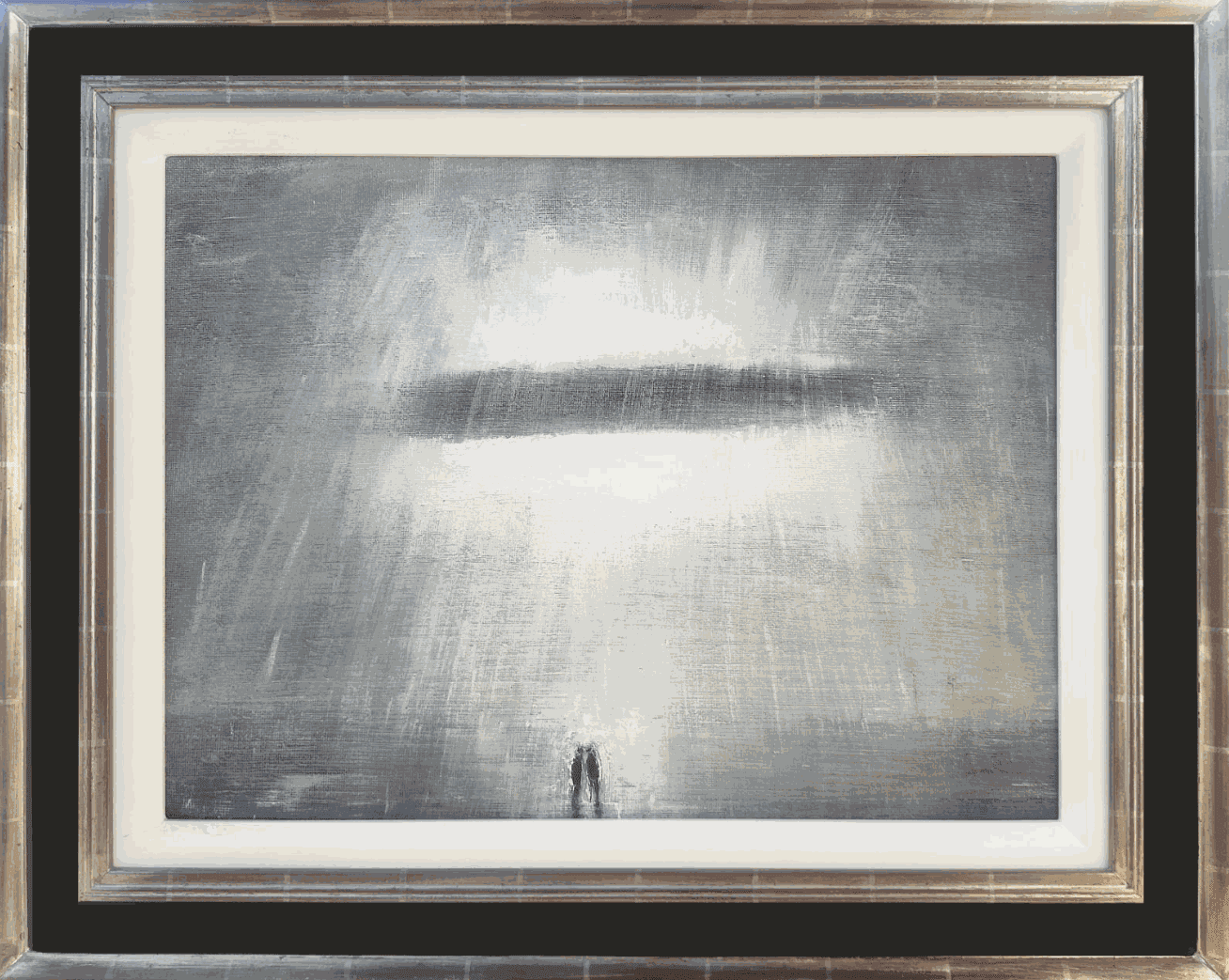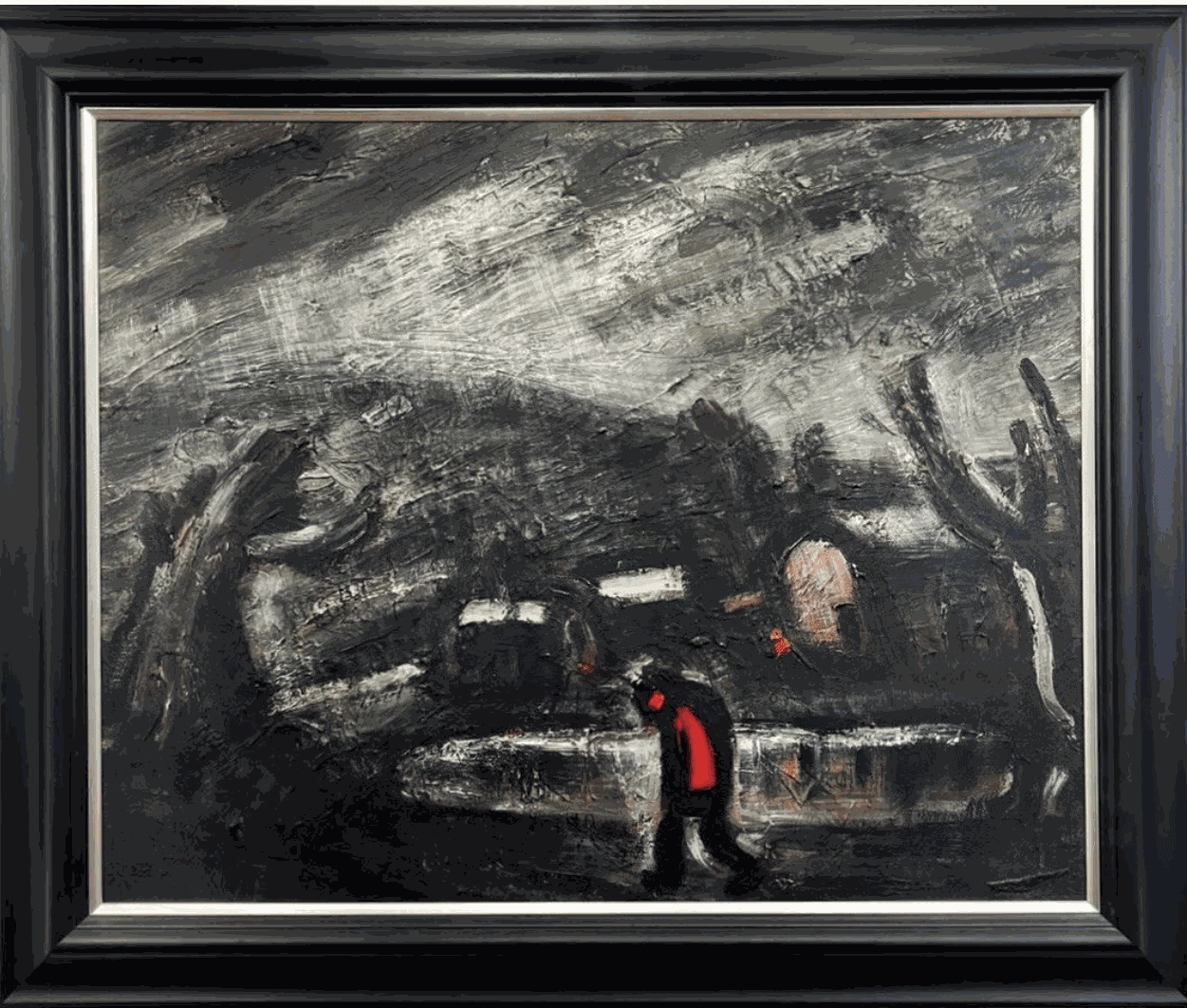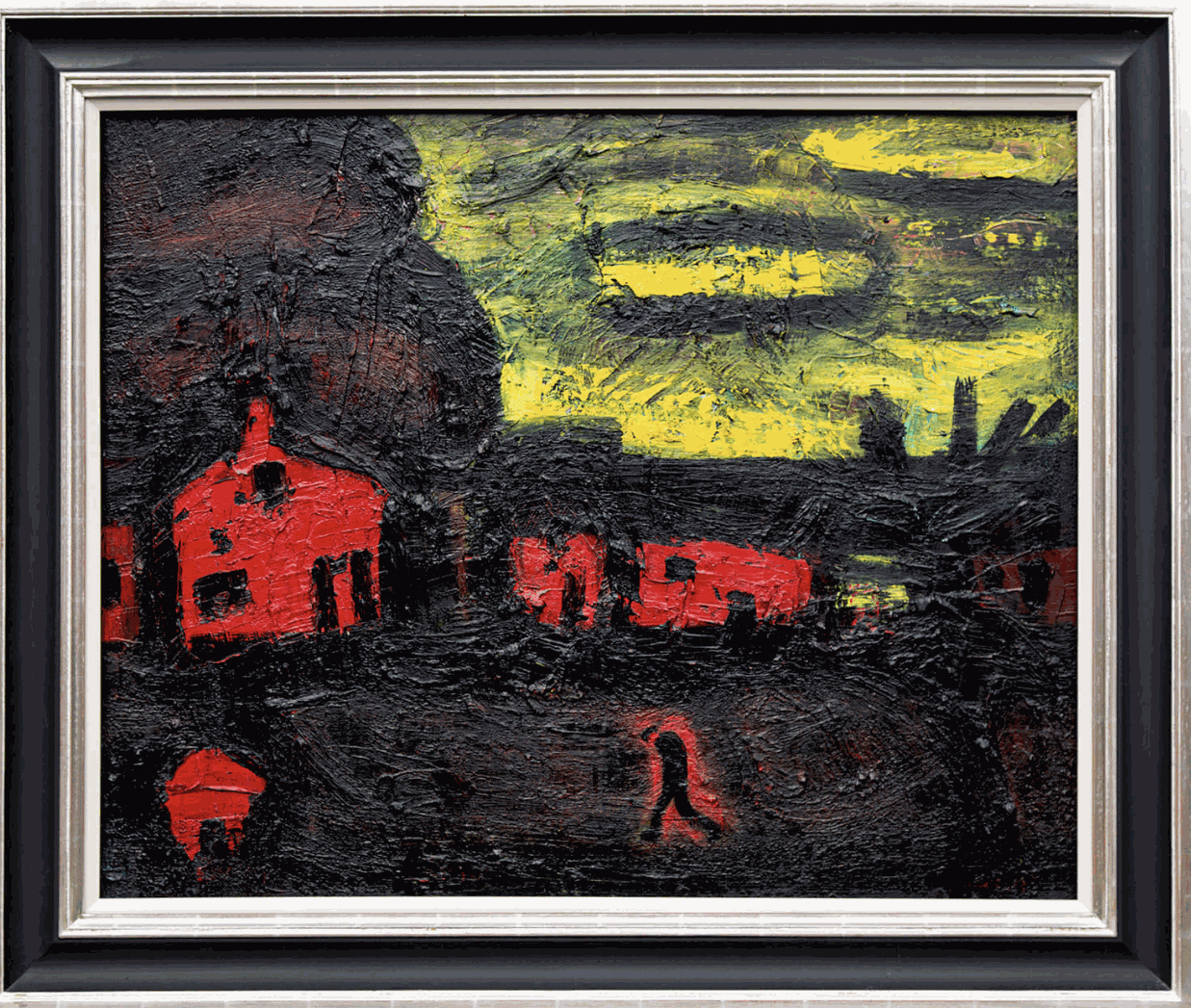Theodore Major isn’t exactly a household name, yet his art carries the sort of emotional weight and visual depth that tends to stay with you long after you’ve seen it. Born in Wigan and painting from conviction rather than ambition, he remains one of the most singular voices in 20th-century British painting. His was an art that asked questions – of society, of suffering, and of spiritual struggle – in a language as direct as it was difficult to ignore.
Major could be called many things: a surrealist British painter, a political outsider, a Lancashire artist with a sense of social conscience that ran deeper than his paint. He distanced himself, quite deliberately, from commercial galleries and art-world validation. In fact, he often refused to sell his work at all. It was always more about message than market.
Still, the paintings speak. And they speak with force of working-class hardship, moral clarity, and quiet defiance. You don’t have to know much about Modern British Art to feel it. That’s what sets him apart.
So, while he might have existed on the fringes, his contribution is hard to overlook. Especially for collectors interested in Northern artists and anti-establishment art, Major still has a lot to say.
Early Life and Background

Born in 1908 in Wigan, a Lancashire town that rarely found itself in the centre of Britain’s cultural spotlight, Theodore Major grew up in a place that shaped him more than any art school could. His upbringing was modest, his father was a mill engineer and the town’s grim industrial setting seeped into the backbone of his work. That said, Major’s talent wasn’t the product of a privileged education. In fact, he was almost entirely self-taught, developing his skills while recovering from rheumatic fever as a child. Art was not an escape, it was more like a reckoning with the world around him.
His early years were marked by personal hardship, but they were also full of learning. A scholarship took him to Wigan Technical College, and later to the local art school, where he eventually became a teacher. Teaching suited him not just as a job, but as a way to stay grounded. He once said he painted for “ordinary people, not the critics,” and that approach extended to his teaching. He didn’t set out to impress, only to communicate something truthful.
His influences were as unlikely as they were powerful. The darkness of industrial England, the moral weight of religious iconography, and the unfiltered emotional charge of working-class life all fed into his early works. He wasn't chasing movements or fashions, Major painted as though compelled. Which, in many ways, he was.
So, by the time he was exhibiting, occasionally, and on his own terms, the voice in his paintings was already fully formed. There was no polite entry into the art world, no gradual transition. Just a Lancashire artist with something to say, and a refusal to compromise.
Theodore Major remains one of those rare figures whose early experiences can’t be separated from the themes he returned to again and again. Wigan wasn’t just where he was from – it was part of how he saw the world.
Artistic Style and Subjects

Theodore Major didn’t paint for decoration. His art was a kind of protest. At a glance, his paintings can feel raw, unsettling, even confrontational. But they weren’t intended to shock for the sake of it. Rather, they held up a mirror to society, forcing the viewer to sit with uncomfortable truths. He painted the human condition; suffering, fear, cruelty, with a quiet intensity that felt deeply personal and unmistakably political.
His work often leaned towards the surreal. Not in a playful or abstract way, but in the sense that it blurred reality with psychological depth. This wasn’t escapism; it was expression. You’d see skeletal forms, ghostly figures, and apocalyptic landscapes – images that seemed to hover between the real and the symbolic. As a surrealist British painter, Major wasn’t mimicking continental styles. He was developing something darker, closer to home, and firmly rooted in his own emotional vocabulary.
War, death, religion, class struggle – these weren’t abstract ideas for Major. They were lived realities, and his canvases became a platform to confront them. One recurring subject was the horror of war. Unlike the clean narratives offered in textbooks, Major’s war paintings were chaotic, bleak, and unforgiving. His own time in the army only deepened his aversion to conflict, and that trauma shows in every brushstroke.
And yet, not everything was horror and despair. Some pieces expressed a gentler kind of spiritual reflection. A longing for meaning in a fractured world. He often spoke about moral decay and the dehumanising impact of modern life. But rather than shout, he painted. Slowly, obsessively. Sometimes over several years.
His industrial landscapes, meanwhile, weren’t picturesque. They were stripped of romance, depicting bleak skies over factory towns, ghostlike workers trudging through soot-coloured streets. These images weren’t about nostalgia; they were commentary. As a working-class artist in the UK, Major wasn’t looking from the outside in. He was in it, living it, and painting with total sincerity.
Major’s refusal to paint for commercial gain only sharpened his focus. He wasn’t bound by trends, patronage, or the market’s appetite. That meant he could dig deeper into themes that interested him, without worrying about how the work would be received. This is part of what makes his portfolio so unusual. It doesn’t pander. It challenges. It asks questions.
So, in that way, his style wasn’t just visual, it was philosophical. And for those exploring politically charged artwork or anti-establishment art, his pieces offer an uncompromising voice. It’s a voice that, even now, feels rare.
Career Highlights and Public Reception
For a man who painted thousands of canvases, Theodore Major kept a surprisingly low profile. His career, if you could call it that, didn’t follow the usual milestones – no blue-chip gallery representation, no lucrative retrospectives, no public courting of critics. He wasn’t interested. That decision, or instinct, to reject the art market was central to how he lived and worked.
Teaching gave him stability. For years, he taught at Wigan Art School, where he was known for his integrity as much as his discipline. He wasn’t there to push students into fashionable styles or marketable techniques. He encouraged sincerity. If anything, he wanted young artists to stop trying to impress and start being honest. His studio wasn’t a production line,it was more like a sanctuary for serious thought.
Although he rarely exhibited, when he did, it tended to leave a mark. There were a few key shows: his work appeared in group exhibitions at the Royal Academy and the Tate, but these were exceptions. More typically, he preferred to exhibit at local institutions, or sometimes not at all. In fact, he famously refused to sell the majority of his paintings. Not because they weren’t in demand (they were) but because he believed they were meant to be seen, not owned.
This refusal baffled and, in some cases, frustrated collectors. But it also gave Major a kind of moral authority. He was principled in a way that felt almost austere. If a piece didn’t feel ready to him, it stayed in his Wigan home, where hundreds of canvases lined the walls. These weren’t stored away – they were lived with, like family.
Critics didn’t always know what to make of him. On the one hand, his work was impossible to ignore. Intense, technically skilled, and thematically rich. On the other, he didn’t play by the rules, which made him hard to categorise. But that outsider status was part of his power. He wasn’t out to flatter the art world. He painted the undercurrent, the grief, the poverty, the things people preferred not to see.
Still, recognition did come. Writers and curators began to frame him as a significant, if unconventional, voice in Modern British Art. Over time, his reputation grew, largely by word of mouth and the strength of his work. And in a way, that feels appropriate. It wasn’t a career he built. It was a body of work; deeply Northern, utterly personal, and starkly relevant.
Legacy and Influence

It’s tempting to call Theodore Major underappreciated but that might miss the point. His legacy isn’t built on fame or sales figures. It’s built on the work itself, and the quiet, enduring respect it commands. In the decades since his death in 1999, there’s been a growing sense among collectors and scholars that Major wasn’t just a fringe figure – he was one of the clearest moral voices in 20th-century British painting.
His refusal to commercialise, once seen as eccentric, now feels almost prophetic. In an age of relentless marketability, Major’s work stands as a reminder that art can be made for reasons other than profit. And that, in itself, has earned him a new wave of interest from serious collectors, especially those seeking politically charged artwork that doesn’t feel performative.
Within Northern art circles, his influence is clear. Younger Northern artists, particularly those tackling themes of inequality, class, and identity, often cite him as a touchstone. There’s a directness in his approach. An emotional and ethical honesty that speaks across generations. You don’t need an academic background to feel the weight of his work. It’s there, in the eyes of his figures, in the scorched earth of his landscapes.
As a working-class artist from the UK, Major carved out a space that others have since stepped into. He showed that serious, intellectually engaged art could come from Wigan just as easily as from London or Edinburgh. That mattered then, and it matters now.
His role in the broader story of Modern British Art is still being written. He wasn’t part of a formal movement, but his work aligns closely with artists who used visual language to speak truth to power. There’s a moral clarity in his paintings and a deep philosophical undertone that makes them resonate beyond their visual form.
Importantly, his posthumous reputation has only strengthened. Major’s works have entered public and private collections, and key exhibitions have revisited his contributions with new appreciation. Interest from art historians continues to grow, and the conversation around anti-establishment art now frequently includes his name.
So, in some respects, Theodore Major didn’t just influence artists, he influenced expectations. He reminded us that art can be tough, angry, even uncomfortable and still be beautiful and necessary.
Where to See His Work Today

Despite his reluctance to sell, a fair number of Theodore Major’s paintings have found their way into public collections, and a handful remain accessible through private galleries like ours at Contemporary Six. So, while he was never one for promotion, his work hasn’t disappeared. Quite the opposite, actually.
Major’s home studio in Wigan, once crowded with unsold canvases, eventually opened its doors to curators and institutions interested in preserving his output. Over time, key pieces entered the collections of museums and public galleries across the UK. Art UK is a helpful resource here – their online database includes several works by Major, giving a glimpse into the range and emotional scope of his painting. From industrial nightmares to quiet spiritual studies, the variety is striking.
Locally, you can find his work in regional museums, often tucked among other Modern British painters but still carrying its own unique charge. His paintings tend to dominate whatever room they’re in, not through size, but through intensity.
For collectors or visitors interested in seeing his work more personally, Contemporary Six in Manchester occasionally features Theodore Major’s work in its exhibitions and private collections. This connection matters. The gallery’s strong reputation for representing Northern artists and its focus on Modern British Art make it one of the few trusted places where Major’s paintings are not only respected but understood.
Viewing Major’s work in person does change your perception of it. Photographs rarely capture the textures, the sense of weight, or the haunted quiet that sits behind each brushstroke. These aren’t works that translate easily through a screen. They ask to be stood in front of.
And if you’re curious to know more, or interested in a viewing, contact us at Contemporary Six to find out which pieces are available or where they might be seen next. It’s not just about ownership – sometimes, just seeing them is enough.
Theodore Major never set out to be a famous painter. And yet, here we are still talking about him, still drawn in by the power of his work. In an art world that often feels too polished, too polite, his paintings remain sharp, unsettling reminders that the job of the artist isn’t always to please. Sometimes it’s to provoke. Sometimes it’s to tell the truth.
He painted for people who rarely had art made for them. He stood outside the art market, by choice, and made work that carried more emotional and philosophical weight than most of his contemporaries. A Lancashire artist through and through, Major captured not just a place, but a kind of collective memory – filled with struggle, spirit, and something close to defiance.
Today, his paintings still resonate. Not because they’ve suddenly become fashionable, but because they never tried to be. For collectors, critics, and casual viewers alike, the appeal lies in their sincerity. Their depth. Their refusal to let you look away.
So, if you’re interested in Modern British Art or Northern artists with something real to say, you could do far worse than start with Major. His voice still echoes, if you’re ready to listen.

